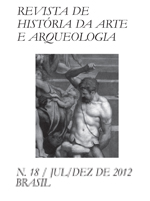Resumo
O presente texto tem por objetivo apresentar o possível uso de simulações computacionais na arqueologia por meio da construção e teste de modelos virtuais e da proposta de desenvolvimento de sistemas autônomos de conhecimento. Para tanto, será apresentado o estudo de caso das Lavras do Abade, onde uma maquete eletrônica do sítio arqueológico foi utilizada para análise e interpretação do espaço constituído.
Referências
BINFORD, Sally R., and Lewis BINFORD. New Perspectives in Archaeology. Chicago: Aldine Press, 1968.
BUCHANAN, Fuce G., and Reid G. SMITH. “Fundamentals of Expert System.” Ann. Rev. CompUi. Sci. (1988). GARDIN, Jean-Claude. Artificial Intelligence and expert systems: cases studies in the knowledge domain of archaeolog y. Chichester: Ellis Horwood Limited, 1988.
BUCHANAN, Mark. The Social Atom: Why the Rich Get Richer, Cheaters Get Caught, and Your Neighbor Usually Looks Like You. New York: Bloomsbury Publishing PLC, 2007.
CLARKE, D. L. Analytical Archaeolog y. London: Methuen, 1968. CLARKE, D. L. Models in Archaeolog y. London: Methuen, 1972.
COSTOPOULOS, A., and M. W. LAKE. Simulating Change: Archaeolog y Into the Twenty-First Century. Salt Lake City: University of Utah Press, 2010.
DORAN, J. E. “Iruba: An Agent-Based Model of the Guerrilla War Process.” In ESSA Conference. Koblenz: PreProceedings, 2005.
DORAN, J. E. “Prospects for Agent-Based Modelling in Archaeology.” Archeologia e Calcolatori, 10 (1999): 33-44. 7 DORAN, J. E. “Systems theory, computer simulations and archaeology.” World Archaeolog y 1 (1970): 289-298.
DURKHEIM, Émile. As Regras do Método Sociológico. São Paulo: Martin Claret, 2008, pp. 31-40.
DYKE, Bennett. “Computer Simulation in Anthropology.” Annual Review of Anthropolog y 10 (1981): 193-207.
GARDIN, Jean-Claude. Artificial Intelligence and expert systems: cases studies in the knowledge domain of archaeolog y. Chichester: Ellis Horwood Limited, 1988.
GILBERT, Nigel, and Klaus G. TROITZSCH. Simulation for the Social Scientist. Second Edition ed. Berkshire: Open University Press, 2005.
GILBERT, Nigel. “Agent-based social simulation: dealing with complexity.” Guildford: Centre for Research on Social Simulation – University of Surrey, 2004.
HODDER, I. Simulation Studies in Archaeolog y. Cambridge: Cambridge University Press, 1977. SABLOFF, J.A. Simulations in archaeolog y. Albuquerque: University of New Mexico Press, 1981.
LANSING, J. Stephen. Priests and Programmers: Technologies of Power in the Engineered Landscape of Bali. Princeton: Princeton University Press, 1991.
MCGUIRE, Randall H., and Paul RECKNER. “Building a working class archaeology: the Colorado coal field war project.” Industrial Archaeolog y Review XXV, n. 2 (2003): 83-95.
MORIN, Edgar. Introdução ao pensamento complexo. Translated by Eliane Lisboa. Porto Alegre: Sulina, 2006.
SOBRINHO, Jalmiro R. “Relatório – VLS 0004.” São Paulo: Alezi Teodolini – Hezolinem, 2005.
WALDROP, Mitchell M. Complexity: the Emerging Science at the Edge of Order and Chaos. New York: Touchstone, 1992. BENTLEY, R.A., and H.D.G. MASCHNER. “Complexity Theory.” In: Handbook of Archaeological Theories, edited by RA Bentley, HDG Maschner and C. Chippendale, 245-270: AltaMira Press, 2007

Este trabalho está licenciado sob uma licença Creative Commons Attribution 4.0 International License.
Copyright (c) 2021 Revista de História da Arte e da Cultura

